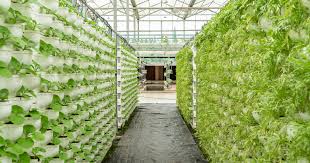Vertical Farming
ENVIRONMENTAL ISSUES
Danny Xu
10/3/20253 min read


The Environmental Benefits of Vertical Farming
With the worlds population rapidly increasing and more people moving to live in cities, the demand for food is rising sharply. Traditional farming methods, which use huge areas of land, large quantities of water, and much equipment are becoming less sustainable. In steps vertical farming—a high-tech method that uses different levels of the same building to plant different varieties under a controlled atmosphere. Not only does vertical farming enable the delivery of fresh food from the city center, but also it provides great environmental benefits that can make it a solution of the future in the agricultural field.
Reduced Land Use
Almost half of the available land on the planet that is suitable for human habitation is currently used for farming. On the contrary, vertical farming relies on stacked systems to grow products upward rather than horizontally. This means that the demand for farmland is reduced significantly, which in turn leaves more land that can be used for natural forests, marshes or wildlife habitat areas. It is important to recognize that these habitats play a substantial role in the fight against climate change as well as the preservation of the biodiversity of the planet.
Water Conservation
Water shortage is one of the major problems with our planet-largely caused by human consumption. Vertical farming solves the problem by employing hydroponic and aeroponic systems that are water- efficient. These techniques can cut total water usage by as much as 90%. Instead of water being released into the atmosphere through evaporation or runoff, its collected, filtered, and reused, which makes for a closed-loop system.
Lower Carbon Emissions
One of the major environmental advantages of vertical farming is the possibility of energy savings due to the elimination of transport emissions. Because vertical farms can be located within or close to a city, food does not have to travel long distances before it reaches grocery stores, This shortens the supply chain and, as a result, the amount of carbon emissions that come from shipping.
Less Pesticide and Fertilizer Use
Vertical farms are set up in an extremely controlled environment, which eliminates almost all pest and disease problems. In other words, minimal chemical matches and plant nutrients will be used, the danger of which can be attributed to the scare of the land, the water, and the organisms that are intertwined with pollination.
Protection Against Climate Change
If a flood, a drought, or a heatwave hits the area in which the traditional agricultural system relies on, extensive damage may be caused. Vertical farming, on the other hand, is designed to be resistant to climate changes. Crops are grown inside with constant lighting, temperature, and humidity. Food production of this type continues to be sustainable amid climate crisis, whereas pressure on vulnerable ecosystems is simultaneously alleviated.
Challenges and Future Potential
One thing to consider is that vertical farms would still need a lot of energy notably for lighting and air conditioning. The production of renewable energy and the development of LED standards is good news because it helps in reducing the energy usage of the vertical farms and overcoming this problem. Thanks to the right kind of innovation and still vertical farming could be used as a complement to traditional agriculture to cut down on its negative impacts on the environment.
Conclusion
Vertical farming is not just a futuristic dream anymore; it is a feasible answer in feeding city dwellers without causing harm to the earth. Vertical farming paves the way for a more sustainable food system through conserving land and water, cutting carbon emissions, and reducing reliance on harmful chemicals. It is no surprise to anyone; this method may become an essential element of insider protection as well as that of the environment when city development continues at a fast pace.
Sources:
Avisomo. 2022. “How Vertical Farming Reduces Environmental Impact.” Avisomo. March 4, 2022. https://avisomo.com/vertical-farming-reduce-climate-emissions/.
Nguyen, Lei. 2022. “Ways in Which Vertical Farming Can Benefit Our Environment.” Earth.org. June 29, 2022. https://earth.org/ways-in-which-vertical-farming-can-benefit-our-environment/.
